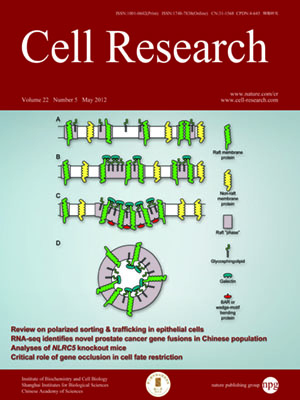
Volume 22, No 5, May 2012
ISSN: 1001-0602
EISSN: 1748-7838 2018
impact factor 17.848*
(Clarivate Analytics, 2019)
Volume 22 Issue 5, May 2012: 806-821
ORIGINAL ARTICLES
RNA-seq analysis of prostate cancer in the Chinese population identifies recurrent gene fusions, cancer-associated long noncoding RNAs and aberrant alternative splicings
Shancheng Ren1,*, Zhiyu Peng2,*, Jian-Hua Mao3,*, Yongwei Yu4, Changjun Yin5, Xin Gao6, Zilian Cui1, Jibin Zhang2, Kang Yi2, Weidong Xu1, Ch
1Department of Urology, Shanghai Changhai Hospital, Second Military Medical University, Shanghai 200433, China
2Beijing Genomics Institute at Shenzhen, Shenzhen, Guangdong 518083, China
3Life Sciences Division, Lawrence Berkeley National Laboratory, One Cyclotron Road, Berkeley, CA 94720, USA
4Department of Pathology, Shanghai Changhai Hospital, Second Military Medical University, Shanghai 200433, China
5Department of Urology, Jiangsu Provincial People's Hospital, Nanjing Medical University, Nanjing, Jiangsu 210029, China
6Department of Urology, the Third Affiliated Hospital of Sun Yat Sen University, Guangzhou, Guangdong 510630, China
Correspondence: Yinghao Sun,(sunyh@medmail.com.cn)
There are remarkable disparities among patients of different races with prostate cancer; however, the mechanism underlying this difference remains unclear. Here, we present a comprehensive landscape of the transcriptome profiles of 14 primary prostate cancers and their paired normal counterparts from the Chinese population using RNA-seq, revealing tremendous diversity across prostate cancer transcriptomes with respect to gene fusions, long noncoding RNAs (long ncRNA), alternative splicing and somatic mutations. Three of the 14 tumors (21.4%) harbored a TMPRSS2-ERG fusion, and the low prevalence of this fusion in Chinese patients was further confirmed in an additional tumor set (10/54=18.5%). Notably, two novel gene fusions, CTAGE5-KHDRBS3 (20/54=37%) and USP9Y-TTTY15 (19/54=35.2%), occurred frequently in our patient cohort. Further systematic transcriptional profiling identified numerous long ncRNAs that were differentially expressed in the tumors. An analysis of the correlation between expression of long ncRNA and genes suggested that long ncRNAs may have functions beyond transcriptional regulation. This study yielded new insights into the pathogenesis of prostate cancer in the Chinese population.
There are remarkable disparities among patients of different races with prostate cancer; however, the mechanism underlying this difference remains unclear. Here, we present a comprehensive landscape of the transcriptome profiles of 14 primary prostate can
FULL TEXT | PDF
Browse 2716


